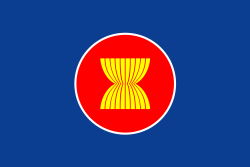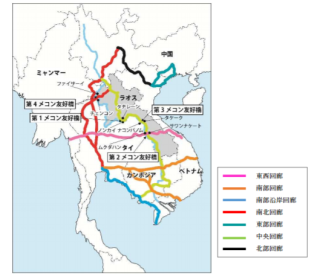The current situation of cross-border transportation
Most ASEAN countries have the attraction that cross-border transportation is possible using the dense overland routes in the Indochinese Peninsula.

Until now, I have reported on cross-border transportation using the Eastern Corridor between South China and Hanoi, as well as the East-West Economic Corridor that passes through Vietnam, Laos, Thailand, and Myanmar.
This time, I will report on the latest situation in ASEAN cross-border transportation.
■ Problems in cross-border transportation
Since cross-border transportation refers to transporting goods across countries, many problems can be caused by differences in the infrastructure or laws of each country.
These problems are major ones that are directly linked to increases in shipping costs.
I have attempted to consolidate the problems in cross-border transportation below.
① Half-Load Problem
The volume of the loads headed from northern Vietnam to Bangkok are far less than the volume of the loads the other way around.

The reason for this is thought to be that although Thailand is a highly industrialised area second to South China, Vietnam is still in the process of developing its supporting industries and has few exports. This issue forces distributors to set transport costs at twice or three times the rate of ships.
This half-load problem exists not only between Bangkok and northern Vietnam but also between northern Vietnam and South China. Cross-border transportation between northern Vietnam and South China does not have a significantly different lead time compared to transportation by sea, but the costs are more than twice as high. Here, the merit of land transportation, namely that it is faster than sea transportation, does not apply.
② Increases in Cost or Time and Reduction in Quality Due to Customs and Transshipment
Customs checkpoints at borders may not have indoor warehouses, and the transshipment of items under open-air conditions may result in the reduction of quality. Furthermore, transshipment at borders is done with LO/LO cranes that can move containers chassis by chassis; however, as these are public equipment, congestion may occur.
Also, as customs rules between the various countries may be opaque and disorganised, problems may occur such as having to spend time waiting for the customs office to open, or having to pay a deposit when passing through customs.
③ Ensuring the Management of Shipping Conditions, e.g. Vibration, Temperature, Humidity
Cargo may be damaged because of vibration during transport on ASEAN’s roads, which are often in poor condition; problems such as rust may also occur because of high temperatures and humidity, since most ASEAN countries are in the tropicss. The development of road infrastructure maintenance is necessary, as well as the use of (??) temperature controlled shipping containers for cargo for which rust is a concern.
■ Dealing with Problems in Cross-Border Transportation, and the Current Situation
① Half-load problem
POINT
・Nurturing supporting industries・Creating an international division of labour through emerging businesses in the same region
As e-commerce in ASEAN has grown considerably, some distributors have solved the half-load problem by using empty containers for consolidated shipments of e-commerce products, thus reducing transportation costs. Furthermore, I believe that this half-load problem will be resolved by the development of supporting industries in the region and the creation of an international division of labour.
As our firm has factories in South China as well, we consider that it may be possible to reduce unnecessary transport costs through the creation of a division of labour between Vietnam and South China.
② Increases in cost or time and reduction in quality due to customs and transshipment
POINT
・The development of legal and customs procedures and increases in transparency in practice
・The digitisation of import/export reports and harbour procedures -> simplification, rationalisation, expedition
⇒ Vietnam and other countries have begun to implement this. However, as the submission of customs documents is still necessary, challenges remain with regards to full digitisation.
・The establishment and unification of customs procedures, including customs bonds procedures -> one-stop customs clearance
⇒ This has begun to be applied at the borders of Vietnam and Laos on the East-West Economic Corridor.
⇒ Congestion sometimes occurs because of customs inspections.
・The revitalisation of logistics through seamless distribution
⇒ Application has begun between Thailand and Laos, as well as Laos and Vietnam
There is a multinational agreement known as the CBTA (Cross-Border Transport Agreement) that deals with improving the smoothness of cross-border transport in the Mekong region. The participants are Myanmar, Laos, Thailand, Cambodia, Vietnam, and the Yunnan province of China. If the “Single Window” provision of the agreement that condenses all import/export procedures at these countries’ respective borders into one step is completely implemented and realised, the temporal costs and complexity associated with procedures and the drawing up of documents will be significantly reduced, and the time spent on procedures is predicted to fall to 30 minutes from three hours. Currently, transportation without transshipment under the CBTA is only possible along the East-West Economic Corridor; for example, transportation from Danang to Hanoi is not possible.
As the transport and legal infrastructure of each country is still under development, it is thought that more time will be required for the achievement of efficient land transportation.
③ Ensuring the management of shipping conditions, e.g. vibration, temperature, humidity
POINT
・The improvement of road, harbour, and transport infrastructure
⇒ e.g. paving, continued maintenance, street lighting, bridge reinforcement, the expansion of harbours and airports, strategies to alleviate chronic congestion
Some distributors have ingeniously used techniques such as air suspension to reduce vibrations caused by travel along poorly maintained roads. Furthermore, although the fourth and fifth Friendship Bridges are opened and infrastructure improvement in the Mekong River basin has been progressing since our visit in 2013, the situation is not yet satisfactory. Further development and expansion is necessary. Furthermore, with regards to the freedom of movement of vehicles, vehicles registered in Laos are currently able to travel in Thailand and Vietnam, but Thai vehicles are unable to travel in Vietnam. The same restriction exists between Thailand and Myanmar.
The ASEAN Economic Community was founded in 2015. It is our hope that through AEC, in which ASEAN member nations with different economic levels, cultures, and ethnicities come together to strive for a single goal, people as well as goods will be able to come and go more freely, and a one-stop customs procedure system will be promptly introduced.
Although ASEAN is experiencing remarkable development, numerous issues remain that must be resolved. Until now, I have reported on cross-border transportation in ASEAN several times. Next time, I would like to bring to you voices from the locations where our firm has carried out cross-border shipping. So that our firm’s activities may be useful to all your businesses, I will continue to report on the latest conditions in ASEAN from now on.
References:
Logistics infrastructure conditions and transport costs in the Mekong region of ASEAN (part I: from Dongguan to Hanoi)
http://www.dynaox.com/solution_en/2014/04/logistic-infra_mekong01.html#nav
Logistics infrastructure conditions and transport costs in the Mekong region of ASEAN (part II: Vietnam and Laos)
http://www.dynaox.com/solution_en/2014/07/logistic-infra_mekong02.html#nav
Logistics infrastructure conditions in the Mekong region of ASEAN (part III: the East-West Economic Corridor)
http://www.dynaox.com/solution_en/2015/01/logistic-infra_mekong03.html#nav
Logistics conditions in ASEAN
http://www.dynaox.com/solution_en/2016/10/asean_logistics.html

